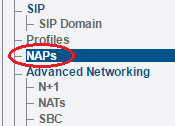Allocating a SIP Network Access Point (NAP)
(Applies to version(s): v3.0)
You must allocate a SIP NAP for your system. To create a new NAP:
Click Create New NAP
Create the new NAP
- Enter a name for the NAP
- Click Create
Verify that the NAP was successfully created message appears
Associate a SIP transport server with the new NAP
The SIP transport server will determine the local IP Address and port from which this NAP will be communicating with remote SIP devices.
Note: It is not recommended to use multiple SIP transport servers in one NAP, because NAP availability may be inconsistent if one of the transport servers is down. For redundancy, it's recommended to create two NAPs and create redundant routes that point to each NAP (using weighted load sharing, or priority routing, as required).
- Select a SIP Transport Server from the Available list
- Click "<<" to associate the SIP Transport Server with the NAP
Enter proxy address
[OPTIONAL] Configure the access control list (ACL)
A NAP with a specific proxy address does not need ACL to be explicitly configured, as the NAP will automatically accept incoming packets from the proxy IP/Port.
It is still possible to configure IP address ranges in the ACL, in order to accept incoming calls from other IP addresses than the proxy.
Associate port ranges with the new NAP
Port ranges will determine IP addresses and ports that will be used for RTP packets with calls using this NAP.
Toolpack will automatically choose non-conflicting ports from these ranges to each call.
- Select a port range from the Available list
- Click "<<" to associate the Port range with the NAP
Note: The port range does not have to be on the same IP Interface than the SIP transport server.
Note: Multiple port ranges on different IP interfaces can be used for load-sharing or redundancy. Each call will be assigned a port from one of the ranges in a "load-sharing" manner.
[OPTIONAL] Associate SIP Domains with the new NAP
Associating a SIP domain to a NAP will allow SIP users to register to this domain from this NAP. Users trying to register from a NAP that is not associated to the SIP Domain will be refused.
- Select a sip domain from the Available list
- Click "<<" to associate the SIP Domain with the NAP
[OPTIONAL]Configure settings for the following parameter groups as required
- Registration Parameters
- Authentication Parameters
- Network Address Translation
- SIP-I Parameters
- Advanced Parameters
- Click Save









